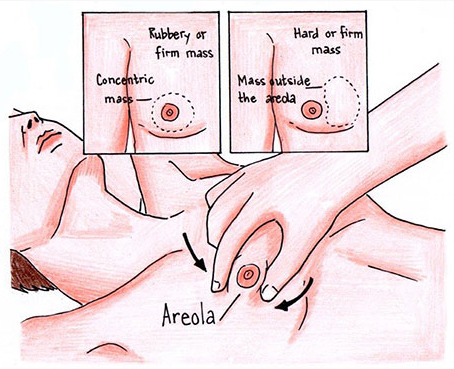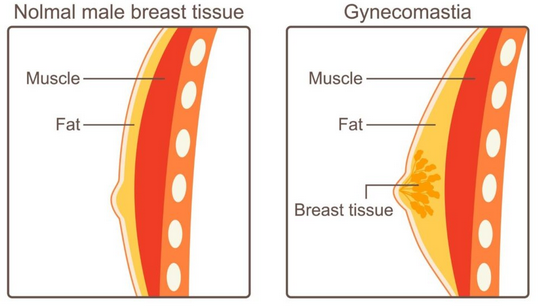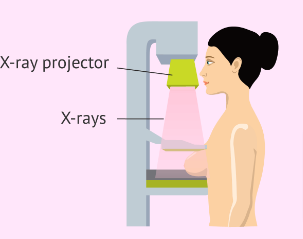Gynecomastia is a condition in men characterized by the enlargement of the breast tissue. It can occur due to hormonal imbalances, medication side effects, or other underlying medical conditions. The gynecomastia pinch test is a simple and non-invasive diagnostic test that can help determine the presence of excess breast tissue.
What is Gynecomastia Pinch Test?
The Gynecomastia pinch test is a diagnostic technique used to identify the presence of excess glandular tissue in the male breast. The test involves gently pinching the breast tissue between the thumb and forefinger to determine its consistency and texture. The results of the test can help healthcare professionals diagnose gynecomastia, and differentiate it from pseudo-gynecomastia, which is caused by an accumulation of fat tissue.
How Is Gynecomastia Pinch Test Performed?
- The gynecomastia pinch test involves gently pinching the breast tissue with the thumb and forefinger.
- The pinch is performed approximately one centimeter away from the nipple.
- The pinch is held for a few seconds before releasing the tissue.
- If the breast tissue feels rubbery or firm, it suggests the presence of excess glandular tissue, which is a characteristic feature of gynecomastia.
- In contrast, if the tissue feels soft or fatty, it is more likely to be pseudo-gynecomastia, which is caused by an accumulation of fat tissue rather than glandular tissue

Before we continue to see what the gynecomastia pinch test is all about, let us first differentiate Gynecomastia Vs Pseudogynecomastia
| Gynecomastia | Pseudogynecomastia |
| Caused By Excess Glandular Tissue In The Breast | Caused By An Accumulation Of Fat Tissue In The Breast |
| Can Affect One Or Both Breasts | Can Affect One Or Both Breasts |
| Often Has A Rubbery Or Firm Feeling When The Breast Tissue Is Pinched | Often Has A Soft Or Fatty Feeling When The Breast Tissue Is Pinched |
| Can Be Caused By Hormonal Imbalances, Certain Medications, And Other Medical Conditions | Can Be Caused By Obesity, Weight Gain, And Lifestyle Factors |
| Typically Requires Medical Evaluation And Treatment, Such As Surgery Or Hormone Therapy | Can Often Be Managed Through Lifestyle Changes, Such As Exercise And Diet |
| May Cause Tenderness, Swelling, Or Discharge From The Breast | Typically Does Not Cause Tenderness Or Discharge From The Breast |
To learn more about Gynecomastia and Chest Fat, check Gynecomastia vs Fat: Do I Have Gynecomastia or Chest Fat?
The Importance of the Gynecomastia Pinch Test in Diagnosing Male Breast Enlargement
The gynecomastia pinch test is an important diagnostic tool for determining the cause of male breast enlargement. Here are some of the reasons why it is important:
- Accurate diagnosis: The pinch test helps distinguish between gynecomastia and pseudogynecomastia, which are two very different conditions. While both can result in male breast enlargement, gynecomastia is caused by excess glandular tissue, whereas pseudogynecomastia is caused by an accumulation of fat tissue. By correctly diagnosing the underlying cause of breast enlargement, doctors can provide the most effective treatment plan.
- Non-invasive: The pinch test is a non-invasive procedure that can be performed quickly and easily in a doctor’s office or clinic. There is no need for anesthesia, incisions, or any other invasive procedures.
- Cost-effective: Compared to other diagnostic procedures, such as mammograms or biopsies, the pinch test is relatively inexpensive. It is also less time-consuming, which means patients can receive their diagnosis and begin treatment sooner. Check Gynecomastia Surgery Cost: What You Need to Know
- No radiation exposure: Unlike mammograms, which use radiation to create images of breast tissue, the pinch test does not expose patients to any radiation. This makes it a safer diagnostic option, especially for younger patients who may be more susceptible to the harmful effects of radiation.
- Effective monitoring: Once a diagnosis has been made, the pinch test can be used to monitor the effectiveness of treatment. By performing the test at regular intervals, doctors can track changes in breast tissue and make adjustments to treatment plans as needed.
Overall, the gynecomastia pinch test is a valuable tool in the diagnosis and treatment of male breast enlargement. Its non-invasive nature, low cost, and accuracy make it a preferred option for many doctors and patients. To be more informed, check Can Gynecomastia Go Away On Its Own?
Who can Perform Gynecomastia Pinch Test?
The gynecomastia pinch test can be performed by a healthcare professional, such as a doctor, nurse, or physician assistant, who has been trained to properly examine and diagnose male breast enlargement. The test is best performed by a plastic surgeon who specializes in treating gynecomastia.
It is important to note that self-examination for gynecomastia is not recommended, as it can be difficult to distinguish between glandular tissue and fatty tissue, and may lead to incorrect self-diagnosis. Therefore, it is recommended to seek medical attention and evaluation by a healthcare professional if you have any concerns about male breast enlargement.
Gynecomastia Pinch Test Results: Interpreting Your Test and What They Mean
The gynecomastia pinch test results can be interpreted as follows:
- Firm or rubbery feeling
If the breast tissue feels firm or rubbery, it suggests the presence of excess glandular tissue, which is a characteristic feature of gynecomastia. Glandular tissue is denser than fatty tissue and is often described as feeling like a firm, rubbery disk or mound. Further evaluation by a healthcare professional is recommended to confirm the diagnosis and determine the underlying cause of the gynecomastia.
- Soft or fatty feeling
If the breast tissue feels soft or fatty, it is more likely to be pseudo-gynecomastia, which is caused by an accumulation of fat tissue rather than glandular tissue. This type of breast enlargement can be caused by obesity, hormonal imbalances, or certain medications. Weight loss and lifestyle modifications may be recommended to reduce the amount of fat in the breast tissue and improve the appearance of the chest.

- Combination of firm and soft feeling
In some cases, the breast tissue may have a combination of firm and soft feeling, which suggests a mixture of glandular and fatty tissue. In these cases, further evaluation by a healthcare professional may be necessary to determine the best course of treatment. To learn more about gynecomastia and chest fat check Chest Fat Vs Gynecomastia: The Best Chest Fat Burning Supplement
It is important to note that you should not rely on your sole means of diagnosing gynecomastia. Seek a healthcare professional and if possible a plastic surgeon with expertise in the treatment of gynecomastia.
Gynecomastia Pinch Test vs. Other Diagnostic Techniques: Which is best?
Comparing the Gynecomastia Pinch Test with other diagnostic techniques is not a matter of which is best, but rather which is most appropriate for a given situation. The Gynecomastia Pinch Test is a non-invasive and cost-effective way to diagnose gynecomastia and can be performed by a healthcare professional during a physical exam. However, in some cases, additional diagnostic techniques may be necessary to confirm the diagnosis or identify underlying causes.
Blood tests can be useful in detecting hormonal imbalances that can cause gynecomastia, such as low testosterone or high estrogen levels. Imaging studies, such as mammograms or ultrasounds, can provide a more detailed view of the breast tissue and help differentiate between glandular and fatty tissue.

In some cases, a biopsy may be necessary to confirm the diagnosis or rule out the possibility of breast cancer. However, this is typically only recommended if there are unusual features in imaging studies or if the patient has a family history of breast cancer.
Ultimately, the choice of diagnostic technique depends on the individual patient and their unique circumstances. A healthcare professional will consider factors such as the patient’s medical history, physical exam findings, and symptoms before deciding on the appropriate diagnostic approach.
How to Prepare for a Gynecomastia Pinch Test: Tips and Advice
Preparing for a gynecomastia pinch test is typically straightforward and requires minimal preparation. Here are some tips and advice on how to prepare:
- Wear comfortable clothing: You may be asked to remove your shirt for the exam, so it’s a good idea to wear loose and comfortable clothing that is easy to remove.
- Avoid using lotions or creams: Avoid using lotions or creams on your chest area before the exam as they may interfere with the test results.
- Discuss any medications with your doctor: Certain medications, such as hormone therapy or steroids, may affect the results of the pinch test. Inform your doctor of any medications you are currently taking.
- Inform your doctor of any medical conditions: Certain medical conditions, such as liver or kidney disease, may cause breast enlargement. Inform your doctor of any medical conditions you have.
- Follow your doctor’s instructions: Your doctor may provide additional instructions on how to prepare for the test, such as fasting before the exam or avoiding certain activities. It’s important to follow these instructions to ensure accurate test results.
By following these tips and advice, you can help ensure that you are properly prepared for a gynecomastia pinch test.
What to Expect During Gynecomastia Pinch Test Procedure
During a gynecomastia pinch test, a healthcare professional will gently pinch the breast tissue between the thumb and forefinger, approximately one centimeter away from the nipple. The pinch is held for a few seconds before releasing the tissue. The test is typically performed on both breasts, and may cause minimal discomfort.
In some cases, a healthcare professional may also perform a visual examination of the breasts to check for swelling, redness, or discharge from the nipple. They may also ask about your medical history and any medications or supplements you are currently taking.
The entire procedure usually takes only a few minutes to complete and is typically done in a doctor’s office or clinic. After the test, your healthcare provider will discuss the results with you and recommend any necessary follow-up testing or treatment.
The Pros and Cons of the Gynecomastia Pinch Test: Is it Right for You?
| Pros | Cons |
| Non-invasive | Can only determine the presence of glandular tissue, not the underlying cause of gynecomastia |
| Quick and simple | May not be as accurate as imaging or blood tests |
| Can be performed by healthcare professionals in various settings | Not widely available in all healthcare facilities |
| Can help confirm the diagnosis of gynecomastia | May not be necessary for all cases of male breast enlargement |
| May be a useful tool in planning surgical treatment | Results may be influenced by factors such as age and weight |
| Low cost |
It’s important to note that whether or not the gynecomastia pinch test is right for an individual will depend on their specific circumstances and the recommendations of their healthcare provider.
Addressing the Myths and Misconceptions Surrounding the Gynecomastia Pinch Test
| Myths and Misconceptions | Facts |
| The Gynecomastia Pinch Test is a painful procedure | The Gynecomastia Pinch Test is a simple, non-invasive procedure that involves gently pinching the breast tissue between the thumb and forefinger for a few seconds. |
| The Gynecomastia Pinch Test is only performed on men who are already diagnosed with gynecomastia | The Gynecomastia Pinch Test is a diagnostic tool used to determine the presence of excess glandular tissue in male breasts. It is often used to confirm the diagnosis of gynecomastia, but can also be used as a screening tool. |
| The results of the Gynecomastia Pinch Test are not reliable | The Gynecomastia Pinch Test is a reliable tool for diagnosing excess glandular tissue in male breasts. However, it should not be used as the sole means of diagnosing gynecomastia, and additional tests may be needed to confirm the diagnosis and identify any underlying causes. |
| The Gynecomastia Pinch Test is not necessary for men with only mild breast enlargement | The Gynecomastia Pinch Test is a useful tool for diagnosing excess glandular tissue in male breasts, regardless of the severity of breast enlargement. It can help determine whether the breast enlargement is due to glandular tissue or fatty tissue, which can affect treatment options. |
| The Gynecomastia Pinch Test is only performed by plastic surgeons | The Gynecomastia Pinch Test can be performed by any healthcare professional who is trained in the procedure. This may include plastic surgeons, general practitioners, and other specialists. |
Bottom Line
The Gynecomastia Pinch Test is a quick and non-invasive way to help diagnose male breast enlargement. While it is not a definitive test for gynecomastia, it can provide important information and help guide further evaluation and treatment. It is essential to remember that the Gynecomastia Pinch Test should be performed by a qualified healthcare professional and should not be used as the sole means of diagnosing this condition. With proper evaluation and treatment, men with gynecomastia can achieve significant improvement in their physical appearance and quality of life. If you are concerned about male breast enlargement or other related issues, it is important to speak with a healthcare professional to determine the best course of action for your individual needs.



